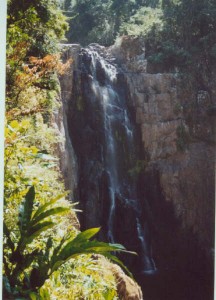Asia has always fascinated me. A visit to Bangkok – before the recent flooding – was a view into a congested urban scene rivaling any of the large cities I have seen around the world. But there are relatively pristine areas as well. A short distance on the map of Thailand – only a two to three hour drive outside Bangkok toward the Cambodian border – is Khao Yai National Park. Khao Yai covers over 2000 square kilometers and includes protected forest, jungle, mountain and grassland habitat. There are also several mountains of around 1000 meters including the magnificent Khao Khieo (Green Hill).
The park is, in a word, amazing. It plays host to almost 2,500 plant species, 67 different kinds of mammals and over 300 species of birds. The abundant wildlife includes many endangered mammals such as elephants, gibbons, tigers, leopards and Malaysian sun bears. On a drive through the park on the main road you start to notice that many of the trees and man-made structures (sign posts, concrete road safety posts) are wrapped in barbed wire to protect them from the wild elephants roaming freely around the park. Still, many of the concrete posts have been pushed over by the elephants. No tigers or bears were observed on my visit, but some magnificently colored birds and packs of gibbons were frequently seen.
 The park is crisscrossed by hiking trails, ranging in length from one and a half to eight kilometers. A fairly short hike took me through the forest to a small stream. After having my photo taken on a rock overlooking what appeared to be a small precipice, I made a very steep hike down to the base of what turned out to be the tallest and most spectacular waterfall in the park. At about 250 feet high, Haew Narok falls is quite impressive (note in the photo below the spot I was standing on above is the flat rock on the top left).
The park is crisscrossed by hiking trails, ranging in length from one and a half to eight kilometers. A fairly short hike took me through the forest to a small stream. After having my photo taken on a rock overlooking what appeared to be a small precipice, I made a very steep hike down to the base of what turned out to be the tallest and most spectacular waterfall in the park. At about 250 feet high, Haew Narok falls is quite impressive (note in the photo below the spot I was standing on above is the flat rock on the top left).
My visit took place during the Thai winter (where 90°F is considered “cool”) and thus the water overflowing the falls was fairly timid. In contrast, park rangers were forced to build massive concrete pilings in the woods to keep elephants away during the rainy season when the water rages down the river and over the falls. Prior to building the pilings, 8 full grown elephants in one night alone were swept over the Haew Narok falls to their deaths.
Just outside the park, I was able to see the elephants close up. Heading for Pakchong Creek, I climbed aboard an adult female elephant for a nearly hour-long trek through the local forest. I rode for a while on a two-person carrier on the back of the elephant as my trusted mahout (driver) guided the elephant through the underbrush. But then it was my turn as the mahout dismounted and I moved down onto the neck of the elephant to guide us the rest of the way through creeks and forest.
From an environmental perspective, the trek through Khao Yai Park and the elephant ride was both heartwarming and disheartening. Tourism has now passed rice production as the biggest contributor to the economy. This increase in foreign visitors brings a broader appreciation for the ecological value of the country. But it also increases the physical demands on delicate ecosystems as more and more people descend on the park, much like the excessive tourist visits to Yellowstone and other American national parks have put a severe strain on the natural habitats, flora and fauna endemic to the regions. It is clear that Bangkok and Thailand must be aware of the environmental and human health ramifications of their continued growth.
Having said that – I can’t wait to go again.












